#there was this stall at the holiday market at union square that had the best babka
Explore tagged Tumblr posts
Text
It is gently snowing outside and I am making chocolate babka from scratch for the first time.
#rachel in real life#there was this stall at the holiday market at union square that had the best babka
16 notes
·
View notes
Text
Lapping it All Up
It's Sunday morning and time to part company with Sue and Peter. It was a fun 5 days. We are heading to Helsinki and they will drive the car back to Riga where it all commenced. They are stopping the night at Parnau. Rainy day again as we said our farewells and they dropped us at the ferry terminal. Saw an amusing sign at the terminal which pointed to the very short term car park (15 mins). It said " Kiss and Sail" which was very apt. We had laughed our way through Latvia and Estonia with them and had covered a bit of ground in those 5 days. Despite it bucketing down Liz did a quick sortie after they left to take a photo of the sign. This led to one of those amusing moments. Something you very rarely see Liz do - "run". If I said a sort of Donald Duck style of running I might be close to the mark. Possibly even being flattering. There is a lot of action, arms flapping, feet akimbo, head rolling from side to side and forward momentum is not speedy. The ferry ride from Tallin to Helsinki takes about 2.5 hours. We had basic tickets so it was first in best dressed for seats. A number of bars and cafes on board and as soon as boarding started the regulars made for prime positions. We had to stow our luggage and were given a bit of a bum steer, in terms of where to store them, by one of the staff so a lot of seats had gone by the time we were free to look. Anyway we snagged a couple of uninspiring but fine seats in a a cafe and settled back for an uneventful trip. Despite the rain it was petty calm and we had a snack, read and blogged. Interestingly they had a couple of stages with musos performing. I might expect that on a cruise ship in the Bahamas but not somehow on a couple of hours ferry in the Baltics. One stage was on the upper deck where quite a raucous bar was in full swing. The wind and rain were coming down on the uncovered end though plenty of cover. Singer was flat as a tack and slaughtered Ed Sheerin's " A Girl Like You" (a bit of a holiday anthem as you hear it a lot in beach bars etc over here). The audience didn't care. They were all getting tanked. Another singer was close to us in a neighbouring area and he was playing the guitar and performing solo with some electronic instrumental help. Not too bad, middle of the road - Eric Clapton, Jonny Cash etc but more importantly his voice I was better. I strolled around looking at the duty free shop where the Finns on board were fairly determinedly stocking up on booze which is much cheaper in Estonia than Finland. This included people with several slabs of beer. Liz noticed that many of those slabs were being consumed on board. It was certainly a lively ship. Trip was easy and we worked out we could get a tram into the city and quite close to our hotel from the ferry terminal. A bit of a scramble getting off but we were in no rush so took our time. Slight problem though, it was raining quite steadily. We headed for the tram stop which was close by but in a master stroke of planning the ticket machine was exposed to the elements and quite a queue. This included the guy who had no idea what to do, did not appear to have the right money (possibly any money), whose credit card would not work and who consequently held us all up in the hissing rain for 5/6 minutes - could have been longer. This on top of the 7/8 mins we had already been waiting. In the end the couple behind paid for him. Liz was now huddled under the tram shelter while I stood out there in the pak-a-mac. No point in two of us getting wet(ter). By the time I got to the front of the queue the wind had set in and rain was horizontal so jeans and shoes pretty soaked. Guys behind (equally wet) who seemed local provided some guidance on the payment process but even they stuffed it up a bit so another minute or two of soaking. Anyway at last I had two tickets in my hand but the various delays meant we just missed a tram by about a minute so had a 6/7 minute wait for the next one. Still, under some shelter, though I was drenched. We duly trundled off for the 10 minute ride and I couldn't wait to get out of my jeans and shoes. I made the mistake of sitting down which was even more uncomfortable so quickly sprang up. Anyway the Hotel Helka was only about a 10 minute walk from the tram stop. Liz did a good job of getting us off at the closest stop and guiding us home. At last, out of that gear and into the shower. All was well and Hey! We were in Finland. Time to explore and we headed off into town. Basically heading for the main square and market square. First impressions were that it was more modern than Riga or Tallinn and a little less atmospheric. Plenty of shopping malls, cafes etc. and even the older buildings which were often quite attractive, of the the six storey terrace variety, did not seem that old. Made our way to market square where there were a number of stalls selling local "products". Very soft hats, wood carvings, paintings, the usual fridge magnet memorabilia stuff but also fox, wolf and reindeer pelts and extremely sharp hunting type knives in scabbards - not sure exactly what the purpose of them was. The market was starting to close but quite a few stalls selling food were in full flight. Now around 4.00pm and we had only snacked post breakfast so were hungry. The offerings were often local delicacies and we couldn't resist sharing a plate of fried Vendace (very similar to sardines) with garlic sauce. Just on a paper plate, pretty decent serve (30 or so smallish fish) you eat the lot, heads and all, and we wandered around happily chomping on them. Very delicious and sauce not too garlicky at all but tasty and needed. It was sun over the yard arm time and we looked for a decent pub/ venue to have a drink. Plenty of craft beer here though we had heard horror stories about the price of alcohol. We couldn't quite find what we were looking for in terms of character but settled on a cafe/bar and sat outside. Rain had stopped but not exactly balmy. After that we continued to wander through the back streets though being Sunday a lot of places closed. Did find a good looking Pho joint which was a possibility if all else failed. Liz loves her Pho. We headed back for the hotel. The Helka is a little boutique hotel and quite quirky. They had a little Swiss style bird house (no birds) that you could deposit your keys in when you left. The coffee mugs in the room had an inscription inside the rim which read " Stolen from Hotel Helka" Staff very friendly and a range of nice touches. We determined that dinner would be in their relaxed little bar/cafe area downstairs. Some good craft beer on tap and bottled and rose OK too. I had the salmon on bread with salad. Big chunks of salmon served cold - excellent. Liz had the coconut and sweet potato soup which was also very good. A local porter and IPA for me (both good especially the porter) rose for Liz. All very laid back and sat very happily not feeling we had to traipse about town. Not too late a night headed up around 10.30 for the usual blogging, reading and planning next phase. Greece definitely on. Thessaloniki as a kick off point looking the goods. Also need to ensure we have a flight out of there to London about a week after arriving in Greece as flying home from London. All pretty tortuous evaluating alternatives but in the end have to bite the bullet and its Turkish airlines to Thessaloniki and BA from there to London though the poms charging usuriously. Liz doing sterling work with bookins Next morning at 11.00 we were going on a free tour of Helsinki. After a great breakfast at the Helka (we expected nothing else given its form to date) we headed for the meeting point a 20 minute fast walk away, back at market square. Our guide was a young and vivacious lady who had spent time in Canada hence a slight North American accent. Super smart and despite a crowd of around 35-40 with a microphone headpiece and a resonant voice she was easy to hear. We covered a lot of ground both literally and metaphorically. Some aspects were: Lutheran religion is the main one for Finns. Apparently a not unusual fall away in those following a structured religious approach in Finland though you have to attend a religious camp for a week when in your late teens if you want to be married in church. A lot of the design of the buildings in the older parts of Helsinki was under the auspices of the German architect Engels in the 19th century. He had spent time in St Petersburg and hence there are similarities between the cities (though not the flamboyant stuff). Education is subsidised in fact you are paid to attend for your first 5 years at Uni. Food is also subsidised for uni students and is free at kindergarten. Start school at 7 pre that it's kindergarten where formal lessons are minimal. At junior school the first 5 years are pretty hands on - sewing, woodwork etc. no homework in that period. Health care free for all though dental must be paid for unless impacts health more generally. We were starting to understand why prices were so high with all those taxes. The guide (Maria I think) quipped that they all live a good life but it's hard to get rich. They were ruled for hundreds of years by the Swedes and then from early 19th century by the Russians. They gained independence in 1917 and in that period also had a bloody civil war. Fought against the Soviet Union in 1939 and collaborated with the Germans to fight against the Soviet Union 1941-44. They did not persecute minorities however. Then they also had to fight against the Germans to remove them from Finland as the tide turned at the end of the war. They are proud to have maintained their independence throughout despite some land losses to the Soviet Union. In winter the harbour freezes over so all boats must be lifted out and stored in dry dock including some pretty large fishing boats. Ice breakers were also visible in the harbour. It was a wide ranging, interesting tour with plenty of fun thrown in. Amazing coincidence of a couple from Melbourne, Meredith and David, being on the tour more especially because Meredith taught the preps at Camberwell primary around the time our kids went there. She didn't teach them as it turned out. Liz and Meredith swopped school and other local stories ++. David was an interesting character. He had worked for the CSIRO and was a resin expert. He had for the last umpteen years supported businesses making wood paneling and other resin involved products around the world. This included a 5 year stint for the whole family living in Italy while he worked there. He had most recently been working in China and had come straight to Finland from there. Yet again there's a lot of different stuff makes the world go around. Nice guy to chat to. Pommie origins though born in Australia and we had a good time dissecting Brexit. He has the same problem as us may lose his European passport. We were interested in the big issues! We did that nattering over a coffee and tea that stretched for about an hour and a half post the free tour. After that Liz and I headed for the market square again and needed something to eat. Beside the square was a pretty attractive and ornate indoor market building. Really it was a tasteful food hall with a range of tidbits you could buy to eat immediately or take away including exotics like reindeer jerky. We plumped for a couple of open sandwiches which we consumed at a little eating area outside by the docks. One was cured salmon and the other was prawns in a sweet chilli sauce. We shared the first two but so tasty we went again. Me for the prawns and Liz for the salmon. Just very nice sitting there with this scrumptious food. Back to the market square and as opposed to yesterday evening all stalls were in full swing so we had a good look around at the knick knacks but did not purchase. Time to go our own ways. We both went looking through shops though Liz also found a strange square which looked like a lunar landscape. People were skateboarding and sitting around the square and it all seemed a bit unexpected in what seems like quite a conservative city. I stumbled across the City Museum. This was a very quirky place which essentially probed some alternative aspects of Helsinki and Finland. One of the highlights was an exhibition by 5 Finnish artists. It was titled "Objection". Essentially it was about disagreement and the role that it plays in our society (particularly Finnish society). Each artist illustrated a different story. One was about Hjalmar Linder the wealthiest man in Finland who fled to Sweden during the 1918 civil war. On his return he found that members of the losing side were still being persecuted (killed) so he wrote a letter to the newspaper saying "enough of this bloodbath" which broke ranks with his peer group. He was then hounded out of the county and eventually died penniless, slashing his own wrists. Another was about left wing activism in the 1930s and 40s. It was being suppressed and so a password " Have you seen a running dog" was used to identify sympathisers. Essentially how people find a way to "object" Yet another was about a book "the Price of Our Freedom" still found in many Finnish homes. It contained a photograph and short description of each of 26000+ people who were killed in the Winter War 1939-1940. The artist had taken the photographs of key people in the book and turned them into ghost like portraits using hundreds of layers of pictures - "the Price of Freedom". Separately there were also general narratives about what Helsinki was like in the past. Pretty rough and ready in the 1920s apparently. Also a photograph gallery with some fantastic photos of Helsinki in the past including one which captured the docks area including market square. I couldn't see a date but perhaps 100+ years ago. All these photos were available for purchase. I kept wandering post the museum. Just walking lost really. Took in a few shops and generally soaked up the city. Liz did much the same. No acquisitions. Liz grabbed a bit of shuteye and we met up again around 7.00 in the hotel bar/restaurant. We decided not to move. The restaurant which the guy in "Radio" restaurant in Tallin recommended was closed ,being Monday night, and the informal dinner they served at the Helka had been pretty good the night before. We both had the open sandwich salmon. Thick chunks of salmon. Liz not the greatest salmon fan (she prefers her fish to be white) but enjoyed it, and I certainly did including polishing a few remnants of salmon from her plate. Of course a couple of craft beers also supped. Liz took it easy as a bit tired and slightly heady. It was relaxing and we headed up around 10.00. I took a quick stroll to walk off dinner but boy had it got cold. I think you can probably keep the Finnish summer. Here we were 12th August and it might have been about 16 degrees out but with a healthy wind that felt around 12-14. I was wishing I had a scarf. This reaffirmed our decision to head back to some warmth in Greece.
1 note
·
View note
Text
FOMA 17: A Modernist Holiday
Yerevan is a hot tourist destination for anyone with a penchant for Soviet modernism. It was robbed of its centrepiece when its Youth Palace – an ear of corn tower with a flying saucer on top for good measure – was demolished in 2006, but the city still has a great deal to offer. Much of it, however, is probably living on borrowed time.
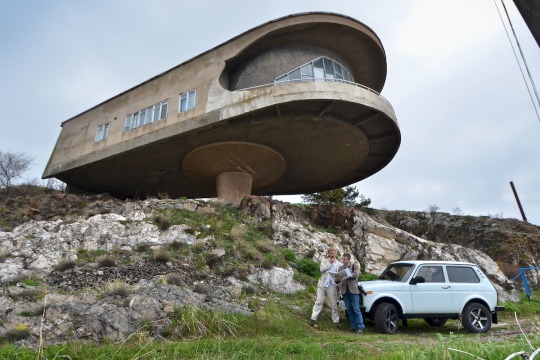
This is an account of a brief trip to Armenia in May 2015. As is my habit, I went armed with a handful of printed Google maps covered in informative scribbles. Modernist civic architecture of the Armenian Soviet Socialist Republic was generally smaller in scale and lighter of hand than that in colder areas of the Soviet Union.

Bucking this trend is Yerevan’s aptly-named Cinema Rossiya, a gigantic and mildly sinister cantilever edifice. Its lower story now serves as a market, its rear enlarged by a mashup of UPVC conservatories and its front by a similarly distasteful modern extension.
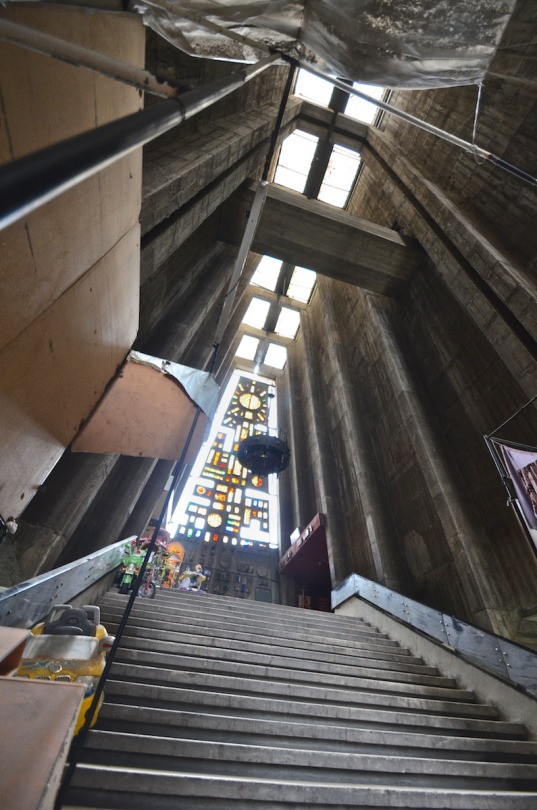
The cavernous cathedral-like hall between the two auditoria is unadulterated but borderline derelict. Our attempts to access the the auditoria were thwarted by paunchy security guards.
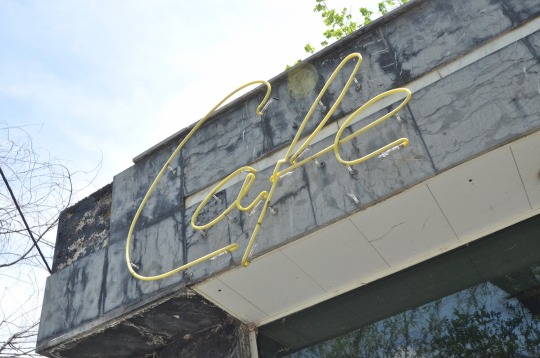
Cinema Rossiya marks the lower end of a semi-circular park that encases Yerevan’s compact centre. The park houses a handful of Soviet-era stalls and pavilions in various states of decay, some with fetching neon signage.
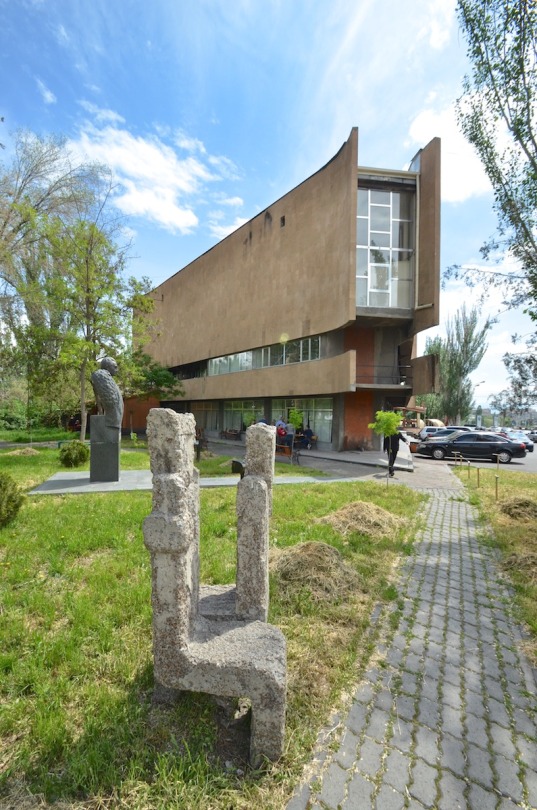
Walk around to the three ‘o clock position and you’ll find the House of Chess Players, a pretty building inside and out that’s an equilateral triangle in plan. It still supported a healthy population of chess players.

At the half-past-one position is the monolithic Komitas Chamber Music Hall, clad in deep red local tuff. It was firmly closed when we visited, posters touting upcoming events providing the only evidence that it was still in use.
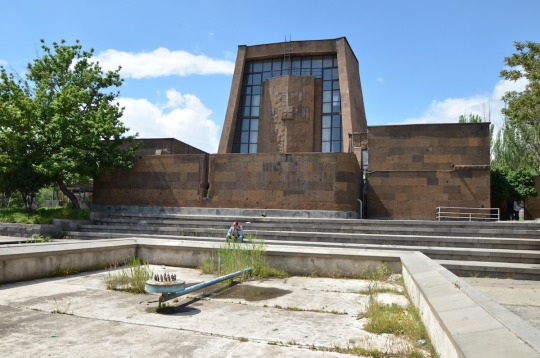
On the next ring-road out on the same tangent is a particularly grandiose example of a cable car station of the sort found throughout the Caucasus. It’s derelict, but its flying saucer shell remains intact and a solitary cable car still hangs at the rear.

At the park’s one ‘o clock position is Yeritasardakan Metro Station, a bizarre construction with a circular light shaft above its entrance hall that sprouts from the ground at a 30° angle like the barrel of a giant mortar.

The Metro is a handsome but nondescript stock Soviet system. From the escalator downward, you could be anywhere between here and St Petersburg.
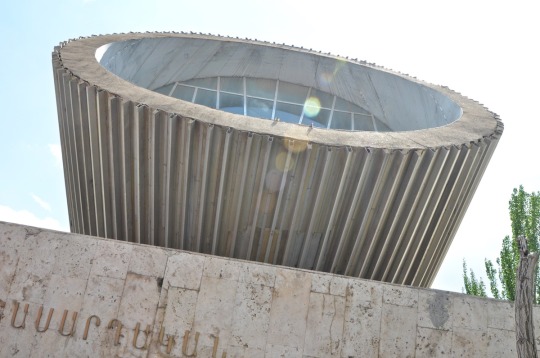
At twelve ‘o clock is the much-photographed Yerevan Cascade, an impressive limestone stairway punctuated by ornate fountains, monuments and some quite weird sculptures. Climbing to the top is vaguely anticlimactic.

The view is reasonable, but it’s nothing compared to that from the mammoth Karen Demirchyan Sports and Concert Complex, a giant sci-fi bunker perched on a hilltop a few kilometers west of the city centre. Despite the addition of tasteless steel cladding and low-grade glazing, the scale and sweeping form of the building remain striking.


The centre of Yerevan boasts a number of other modernist buildings of note – and there are various others in the vicinity that I didn’t have time to visit. It’s definitely worth scheduling a few days if you can. It’s generally a nice place to spend time. Ararat brandy is excellent and Kilikia beer adequate.

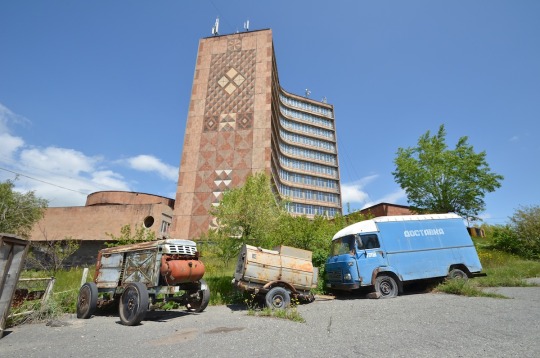
Leaving the city in a northeasterly direction, you’ll pass the former Institute of Stones and Silicates – a shapely three-pronged office block adorned with tilework that showcases Armenia’s colourful palette of volcanic stone. A little further on is the Northern Bus Station.

On the outside it’s a confusion of crumbling red tiles and unkept foliage. In the inside, however, it’s an airy and elegant palace of sweeping staircases and balconies clad in polished stone. Beautiful as it is, its purpose is a puzzle.

It now houses a solitary ticket booth and a terminally closed café, but it’s hard to imagine that much else has ever happened there. The second floor sports a solitary RAF Latvia minibus perched above a treacherous spiral staircase that’s either had its balustrade stolen, or it never had one in the first place.
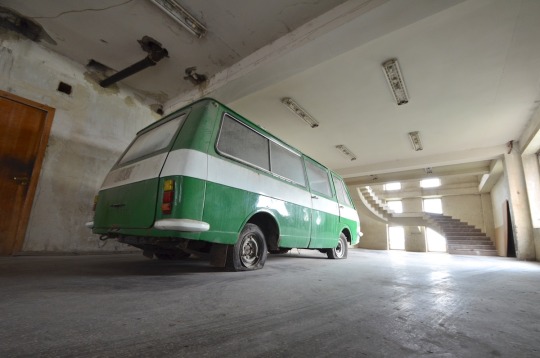
Nearby, incidentally, is the remarkable Levon’s Divine Underground (5th street, 9th house Arinj, Kotayk to be exact). Local builder Levon Arakelyan started digging a cellar beneath his small suburban house in 1985.

Two decades later, he’d excavated a 300-square metre labyrinth. It’s a work of solitary human obsession that a rivals any Werner Herzog film. Levon sadly passed away in 2008, but his wife, Tosya, will give an enthusiastic tour for a small fee if you knock on the door and she’s not busy.
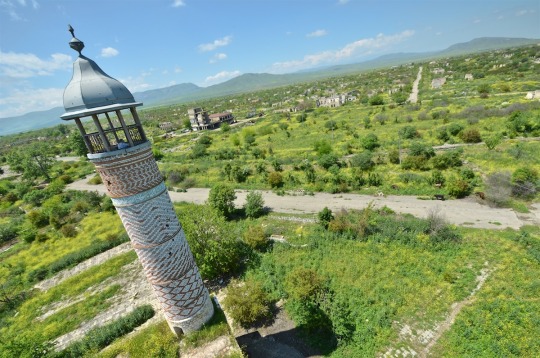
We hired a Lada and drove to Nagorno-Karabakh, a self-declared and much-disputed autonomous republic within the borders of Azerbaijan. Its Ruritanian and mafia-rich capital Stepanakert was culturally fascinating, but we found little of architectural note. There are a few grand Soviet monuments dotted around the countryside.
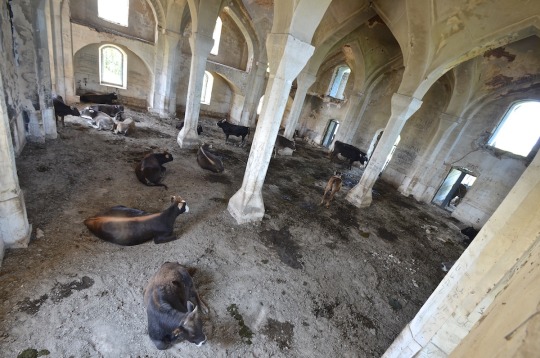
The ghost town of Agdam – raised during the Nagorno-Karabakh war in the 1990s – houses a solitary stone mosque. Once a fine example of 19th Century Karabakh architecture, it’s now in a very sad state and filled with cattle.
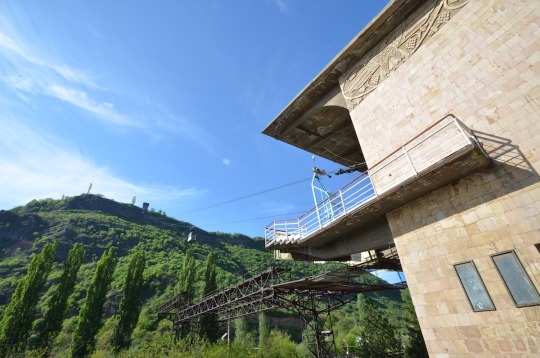
On the way back to Yerevan we visited Alaverdi, a grim copper-mining town that sustains one of the few Caucasian cable cars that’s still in working order. The ride was picturesque, if a little terrifying.
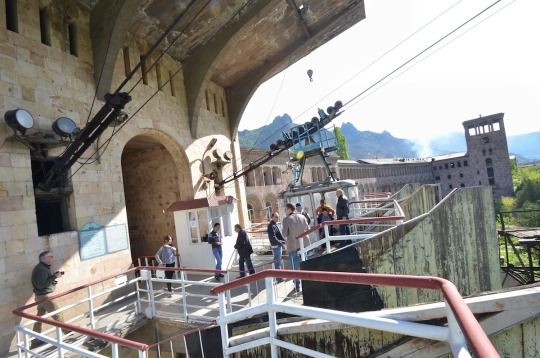
Next, we swung by Sevan to inspect the canteen of the Armenian Writers' Union – best known as the cover shot of the excellent book Soviet Modernism 1955-1991: An Unknown History (find the review here).

It was as striking and otherworldly as anticipated. Photographs don’t do justice to its location. It hovers high and lonely on a rocky hillside, its 180° window offering a bleak panoramic view of Lake Sevan.

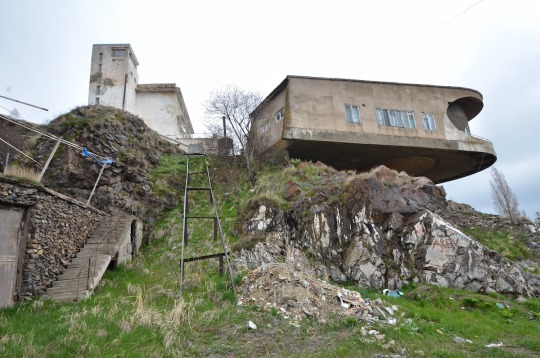
The best came last. Unless you travel overland from Georgia, it’s more-or-less impossible to visit Armenia without passing through Zvartnots International Airport.
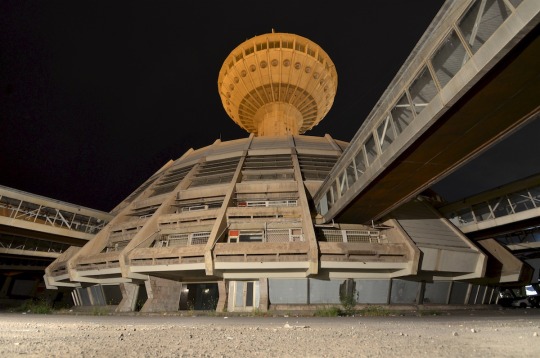
The new Terminal 2 (2006) is pleasant enough, but forgettably generic. The old Terminal 1 (1971), closed since 2011, is enormously exciting. It’s a space-age concrete fantasia.
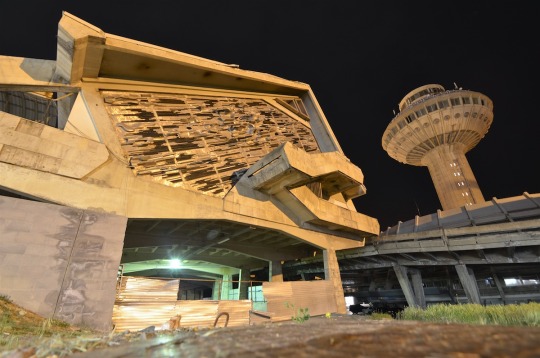
A flying saucer control tower sprouts from a rotund central check-in area, orbited by a ring of departure lounges connected by flying walkways. It was totally abandoned when I visited in the early hours of the morning, save for a few security guards who did a fine job of pretending I was invisible.
I spent two very happy hours wandering around unhindered and admiring its many thoughtful intricacies. Few buildings demonstrate so spectacularly what a disappointment the future has turned out to be.

I suspect that security has now been heightened. If it hasn’t, I’d urge anyone that finds themselves in the vicinity to go and have a poke around. Like most modernist architecture in Armenia, I fear its days are numbered.
___
#FOMA 17: Sam Glover
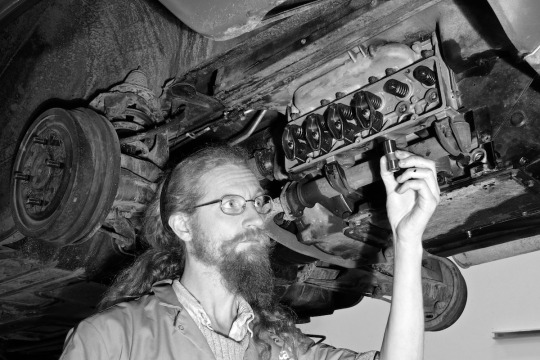
Sam Glover is a writer and engineer from the United Kingdom with a penchant for exploring remote parts of eastern Europe and the former Soviet Union. In his project Soviet Modernism, he aims to visit and document as much socialist modernist and constructivist architecture as he can before it’s defaced, demolished or improved. He is technical editor of Practical Classics magazine and specialises in the restoration of unusual classic cars. He has a First Class Honours degree in Design from the University of Sunderland.
217 notes
·
View notes
Text
Kyiv, Ukraine’s Dynamic City on the Dnipro
Kiev or Kyiv, is the vibrant capital of Ukraine. Full of colourful cathedrals, parks, funky cafes, colourful street art, exciting nightlife and delicious vegan food.
I would go as far as saying that is one of Europe’s most underrated travel gems.
I was curious to finally visit this former Soviet nation since I’ve only visited a few countries that used to be part of the Soviet Union (USSR), Estonia, Latvia, Lithuania, Georgia and Armenia.
Ukraine is the second-largest country in Europe, famed for its beautiful historical cities, unusual-flavoured vodkas, beautiful beaches in the Crimean Peninsula, wonderful churches, and soviet architecture.
I felt on my time in Kyiv that the city has a huge amount of potential and it had the surprising feel of being somewhat off the beaten track when compared with other European capitals.
Exploring Ukraine’s exciting and engaging cultural capital
UNESCO Sites
Kyiv has two UNESCO World Heritage sites. Both are Orthodox Christianity icons. Kyiv Pechersk Lavra and the Saint Sophia Cathedral.
St. Sophia Cathedral
I found that the interior was the most outstanding aspect of St Sophia’s Cathedral. The oldest standing church in Kiev, with its striking original frescoes and mosaics from the early 11th century.
The bell tower is also worth climbing for great views over Kiev.
Pechersk Lavra also known as the “Monastery of the Caves” comprises an ensemble of monastic buildings, overlooking the right bank of the Dnieper River.
Founded in the 11th century, Lavra has a number of gold-domed churches and an underground complex of labyrinthic caves that expands for more than 600 metres.
The monks dug caves and underground labyrinths, living and studying in them, and their mummified bodies still line the walls.
Walking around the caves was definitely an ‘experience’ that I will not repeat. I felt that was a place that should only be open to people that go there to pray, I was the only tourist there walking around in the dark and narrow passages while believers congregate from one relic to another, praying and kissing each icon and the numerous vaults which contain the mummified bodies of the monks in turns.
Cathedrals and more Cathedrals
When visiting Kiev you will not escape from visiting at least a few Orthodox Christian Cathedrals. Don’t get me wrong, they are beautiful, unique and different from what I’m used to, but after a while, I had to have a break from all the religiousness.
I honestly can’t decide which one I liked better. They were all beautiful with their golden tops glimmering with glory. So here is the list of my favourite ones:
St. Volodymyr’s Cathedral
Built-in the late 19th century, St Volodymyr’s Cathedral is not one of the most famous but I found the interior absolutely stunning, with art nouveau influences.
The exterior is yellow and has seven blue domes.
St. Michael’s Golden-Domed Monastery
This golden-domed blue church is hard to miss out. Looking from St Sophia’s past the Bohdan Khmelnytsky statue, at the other end of proyizd Volodymyrsky. The shiny cupolas are absolutely stunning and also the murals inside.
St Andrew’s Church
This Golden and blue baroque church is a traditional Ukranian five-domed crossed-shaped church, that dominates the view as you walk up Andriyivsky uzviz.
Make sure you climb the steps to the platform for great views over Podil and the Dnipro River.
An Introduction to Kiev at Independence Square
Maydan Nezalezhnosti square (Independence Square)
Maydan is the nation’s meeting point, where people come to stroll and enjoy the nightly fountain show.
Kiev’s big social heart hosts many concerts, performances and festivals, and it is known for its vibrant and lively atmosphere. The independence Square is filled with fountains and glass domes.
Annually you can see here on August 24, the celebration of the independence, with a military parade.
Stroll Along Kreshchatyk Street
Khreshchatyk Street is lined with neoclassical buildings, cafés, and upscale shops. You will probably walk this street almost every day in order to reach different sights in various parts of the city.
On weekends and holidays, the road is closed to traffic.
Highlights in Kyiv’s Old Town
Is at Kyiv’s Old Town, (also known as the Upper Town), that you can find the oldest and most important landmarks of the city, perfect for aimless walking… admiring ancient ruins and gracious baroque architecture.
Discovering the Best of Kiev
Podil- In the heart of Kiev
The historical area of Podil is one of the most dynamic and coolest areas in Kiev. It truly has a bohemian, revivalist feel that really resonated with me.
Podil is full of stylish cafés and restaurants, art galleries and cultural centres, street art and historical orthodox churches.
Part of the joy here is wandering around without any specific purpose.
Strolling Around Andreyevsky Uzviz
Andreyevsky Uzviz (or Andrew’s Descent) is a charming winding cobblestone street. The area has a bohemian vibe, and is a wonderful place to stroll. The main street is filled with galleries, shops, restaurants, cafés, artists’ co-ops and studios. Stop to check out the open-air vintage markets along Andriyivskyy Descent.
The Bustling Bessarabsky Market
Is a massive indoor market filled with stands selling fresh produce, jar upon jar of pickles and preserved everything! The produce is stacked beautifully and you’ll see lots of traditional Ukrainian products.
Other cool and unique things to do in Kiev, Ukraine
Kiev’s ‘underground economy’
As other post-communist countries, there are several underpasses at busy intersections. Where you can find people selling all sorts of goods – these mini-market stalls truly seem to be a part of people’s everyday life.
So marvelling at all the economy that is taking place underneath Kyiv’s walkways is a must.
Take the metro to the deepest station in the world
The metro in Kiev is cheap, reliable and a great way to get around.
Kiev metro is one of the deepest metro systems in the world, and Arsenalna Metro is the deepest metro station in the world (346 feet underground).
Go on a self-guided street art tour
The scale, quality and quantity of the street art in Kyiv is impressive and not to be missed.
Eat amazing Vegan food
Veganism is on the rise, and Kiev is not an exception. There are lots of interesting places to be found and delicious food to be appreciated.
Ride the funicular
The funicular is not a tourist attraction, is one of the many public types of transport you have in the City. Is just a short trip, but nice, especially for the views. A simple way to travel from upper to lower city.
The funicular runs down a steep hillside to the river terminal in the district of Podil
Catch an Opera or Ballet
While in Kiev you should admire the amazing architecture of the opera house and see an Opera or Ballet show. They are quite affordable, and Ballet is known for being popular in the Ex-Soviet states.
PinchukArtCentre
The international centre of the contemporary art – PinchukArtCentre, It’s the largest exhibition area in the whole of Eastern Europe.
They have excellent free rotating exhibitions, and great views of Kyiv’s roofs from the coffee shop on the top floor.
Holosiivskyi National Nature Park
The Holosiivskyi National Nature Park is a protected forest and nature reserve in Kyiv and a must-visit for nature lovers.
Navigating Your Way around the city
Transportation in Kiev is cheap by most European standards. The metro in Kiev is one of the most efficient in the world.
Kyiv, a city that has it all
Kiev will surprise you and leave you pining to book a return trip, I really enjoyed my time in Kyiv, and I bet you’ll love it as much as I did.
What was your experience in Kiev? Or are you planning to go?
Kiev travel guide Kyiv, Ukraine’s Dynamic City on the Dnipro Kiev or Kyiv, is the vibrant capital of
0 notes
Text
The Villages of Sierra Francia Salamanca
Every time I visit the Sierra de Francia mountains, and I’m lucky I have family there so visits are regular, I fall in love with the place all over again. After life in Madrid it’s like a warm, peaceful security blanket folds around me.
With some wonderful (and incredibly good value) casas rurales and guesthouses throughout the area, it is the perfect place to unwind and enjoy some real Spanish rural tourism. In this post, I´ll share some knowledge about some of my favourite villages in the area along with recommendations of where to stay, and other tips.
What’s ahead:
Introduction to the amazing Sierra de Francia’s Visiting La Alberca Finding Fossils in Monsgaro Are you being watched in Mogarraz Castles and wine in San Martín del Castañar How to get to the region
Estimated read time 5 – 6 minutes
Welcome to sleepy my piece of paradise
Though within relatively easy distance of Salamanca, it’s rumoured that throughout the Franco years the villagers of Casares de Las Huertas weren’t even aware there was a war raging.
While that isolation has diminished with the advance of good roads and communications, I’m still more likely to have a conversation with a resident about the condition of their apple trees, or who’s jumped the queue for the irrigation channels that divert the mountain streams to their crops, than the latest outpourings of President Trump (“Quien?”) or European Union politics.
It’s not that they can’t keep up with national and international news it’s just not important enough to intrude on real lives. It’s this internal focus over the centuries which has preserved rich community traditions and still values life at a slow pace.
The Monestary atop La Peña de Francia
Most settlers came from families of French origin around six centuries ago, giving the area its name and also its wonderfully alpine-feeling architecture. Almost isolated amongst the forested mountains, many small villages have grown up around the area’s centrepiece – the peaceful mountaintop monastery La Peña de Francia. Here are a few of my favourites . . . welcome to the villages of Sierra de Francia.
La Alberca
La Alberca is one of the largest of the villages to have grown up under the watchful eye of La Peña de Francia and is an ideal place to base yourself when visiting the region. It’s a handsome medieval town and as I stroll through the narrow streets I could easily imagine myself in the French Alps.
The handsome timber fronted houses
For me the thing that really stands out is the architecture – the narrow streets are sided by large stone and timber houses with dark wooden balconies awash with colour from the floral displays. It seems that all the neighbours try to outdo each other and the result is rather marvellous.
In the centre of La Alberca is the Plaza Mayor, giving the town its heartbeat. Coffee shops and restaurants are busy as people gather, as they do across the world, to gossip about the latest local scandal and, when I was visiting, small market stalls were selling local kinds of honey and ham.
Just around the corner you’ll find the church. It looks interesting and I’m sure it has a lot of history, but I was more taken by the random statue of a pig outside. Turns out it wasn’t random at all and is actually a monument to one of the town’s favourite events.
El Marrano de San Antón
The statue is of El Marrano de San Antón (The Pig of St Anthony in English) and relates to a yearly tradition of having a pig live among them on the streets.
Each year, a lucky porker is blessed during a celebration on 13th July before being left to wander freely around the streets being fed by the generous residents. However, after six months the luck abruptly runs out as its time spent being the town’s guest of honour comes to an end when it’s raffled at the doors of the church to raise funds for the Brothers of St Antony.
Now I like to think a heroic local resident buys the pig each year and releases it, but more likely it ends up on a barbecue.
So what’s special about it and why should you visit La Alberca? Well, in all honesty, I can’t really put my finger one thing. But a little over 60 years ago, the village was one of the first in Spain to be given the legal status of an Historic-Artistic Monument for its architecture. So I guess that’s your answer, all of it stands out!
Recommended places to stay in La Alberca
La Esquina de Animas
La Casa del Burro
Search more hotels in La Albera.
Monsagro
Translating to Sacred Mountain, Monsagro is always my base when visiting the region (as I get to stay free with family). It is a wonderfully tranquil village and quiet even by off the beaten track standards.
Monsagro, part of La Ruta de las huellas fósiles
The main road between Salamanca and Ciudad Rodrigo (the largest town in the area) and La Peña de Francia (the main reason people visit the area) avoids this village completely, so it barely even appears on the map.
With only a handful of year-round residents (all of whom seem to spend most of the day sat on little benches outside their homes watching the world not go by), at certain times it truly feels like the village is deserted. However, in summer it comes alive as families return for their summer holidays and enjoy the village celebrations.
Village among the mountains
Monsagro’s main claim to fame is fossils. Millions of years ago this whole mountainous area was under water and fossilised remains of marine life are scattered throughout the rocks. Many of these fossils are now built into the houses and there is even a fossil trail you can take around the village.
Although the village may feel like a bygone era, that is not the case. The village mayor works closely with the University of Salamanca to promote the village and its fossils to the geotourism community and it even has its own app. That’s right, using the power of augmented reality, the fossils come to life as you wander throughout the village.
Down by the Río Agadón in Monsagro
Aside from fossil hunters, Monsagro is perfect for hikers as it’s set in the middle of the Batuecas Natural Park with hundreds of kilometres of forested mountain paths alongside the river Agadón. And if you like your food, there is an amazing ham shop. The region is famous for Iberico Jamon, and here you can find some of the best, as well as delicious chorizo and other local produce.
Places to stay in Monsagro
There are two places you can stay in the village, a lovely small hotel complete with bar and restaurant, or if you want to do it all yourself, there is a simple, but cosy, casa rual complete with roof terrace.
Mogarraz
Possibly my favourite of the villages on this list, Mogarraz preserves the mountain architecture with a network of irregular, narrow and small streets along with spaces and cosy squares.
The paintings of Mogarraz
Built on quite a steep slope, it is another village in the area with the title of an Historic-Artistic Site for its historical and cultural heritage. You can easily just drive past and miss this village as the road runs above and past it. As it doesn’t allow cars, you have to park at the top and wander down.
There are two things that really make this stand out for me. Number one, wine. Now if you have read many of my posts you may well have realised that I do like the odd vineyard visit. Mogarraz is home to one of the region’s finest producers, La Zorra.
One of the regions best wineries
The village sits within one of Spain’s newest DOs – Denominación de Origen Sierra de Salamanca, and La Zorra stands out as one of the DOs best. Most of the wine is produced from a rare grape that is indigenous to the local area, Rufete, but also Aragones (the local name for Tempranillo).
You can book tours of the winery and do a tasting (highly recommended) and they have an English-speaking guide most of the time – sadly not when I visited but I had my translator with me, and the wine tastes great in any language.
But it’s not just La Zorra. As I wandered down to the main village square I saw many of the houses had signs above their garages advertising themselves as bodegas (Spanish word for cellar). Many people here make and sell their own wine too and while the quality can’t always be assured, there are some gems to be found and enjoyment to be had by looking (and tasting).
Painting of residents
OK, so point number two that makes Mogarraz unique. Have you ever felt like you are being watched? Well wandering around here you will. What brings most people here are the stories of the portraits that hang outside almost every house, watching you as you tour the streets.
Giant canvas paintings hang from the houses with images painted by local artist Florencio Maillo and based on a series of 388 photos that were taken for identity cards in the 1960s. However, the village liked them so much that they asked the artist to continue and the portraits include current residents too.
This unique addition to the village makes wandering through it really enjoyable, if somewhat creepy. There is a small square with a couple of restaurants where you can recover before walking back up the hill.
youtube
Places to stay in Mogarratz
Apartamentos La Zurdina Apartamentos Azahar Apartamentos Anateresa
Search more places to stay in Mogarraz
San Martín del Castañar
Slightly larger than both Moggaraz and Monsagro, San Martín del Castañar has grown up around its main street with a church and castle at one end, a river complete with swimming area and bar at the other, and the Plaza Mayor in the middle.
The castle is located at the top end of the town and is free to walk around. Although not overly spectacular in itself, it does offer some fantastic views of the surrounding mountains and the Batuecas Natural Park.
Next to the castle is the bullring which people here say is considered to be the second oldest in Spain. Now I’m not sure who considers it to be, but I love the idea. I’d imagine that if you claim it is the oldest you’ll come under a lot of scrutiny and people will try to prove you wrong. But who’s going to refute the claim of second oldest?
the second oldest bullring in Spain . . . possibly. By Cruccone – Own work, CC BY 3.0
This area is also where you’ll find another fine producer in the Sierra de Salamanca DO – Versos. I have a separate post about when I visited the Versos museum and ate there with my parents, I highly recommend it.
As you head down from the bullring you’ll pass the 16th-century church, dedicated to San Martín de Tours, but more importantly, next to it is one of the finest bakers in the region, the Panadería Y Dulces De Artesanía Sierra De Francia.
The region’s architectural style of high, wooden timbered houses continues to dazzle out as the road through the centre of the village reaches the Plaza Mayor, a large open square with the town hall, fountain as well as a few eateries and souvenir shops selling local crafts.
By Sotos CC BY-SA 4.0, from Wikimedia Commons
One of the stores opposite the town hall specialises in selling local produce. I had a good chat with the owner who was telling me the troubles that face the village.
He explained that the young ones growing up have no interest in learning the traditional way of life in the area, most of them leave to work in bigger cities such as Salamanca or Madrid and don’t come back. To help counter this he is spearheading a project that brings students in from all over Spain, they stay in the village and help farm, learning the culture and history.
I guess that rural to urban migration is something that affects every country but it’s nice to see some people and projects designed to help reverse the trend.
Finally, at the lower end of the town you will reach the river. Well, more of a stream that is a tributary to the larger Rio Francia. But this stream has a great little swimming area complete with outside bar. A perfect place to grab a drink and cool off after a hard day of touristing.
Where to stay in San Martín del Castañar
To be honest, I have no recommendations, but you can take a look for yourself, just click to search accommodation in San Martín del Castañar.
How to get to Sierra de Francia
As you’d expect, being so far out of the way, it’s not the easiest place to get to by public transport, not impossible, but you’re better off hiring a car if you don’t live in Spain and have one yourself.
The closest (largish) airport to the Sierra Francia mountains is in Valladolid, a city about two and a half hours away, however, you are much more likely to find flights to either Madrid or even Porto in Portugal, both are about 3 and a half hours away.
If you are set on public transport it is possible. To get to the villages you would need to first get to Salamanca, easily done from all major cities by train, and then hop on a bus to Cuidad Rodrigo, a small city at the entrance to the mountains. From here it’s another bus which goes through all the villages and runs about twice a week, so planning is definitely advised.
While I wish I could tell you it’s easy to get to, it’s not, but I don’t mind that. It is this difficulty that has allowed it to remain isolated for so long and preserve many of the traditional ways of life. It is this quietness that I love when I visit, feeling like I am the only one in the world that knows about this sleepy paradise. Now I may be contradicting myself by writing, and sharing it with (hopefully) the masses of readers, but if someone is willing to make the journey, I am willing to share one of the world’s rare, truly authentic places.
Your turn
So what does your paradise look like? are you a mountain, beach or city person, let me know in the comments and I’ll check it out!
As peaceful as it gets
Are you a Travel Blogger?
If you want your blog to be added to our map be sure to check out our submit your blog page here: http://bit.ly/2YN0dJO
Search for travel blogs from Europe
Recent blog posts from Europe
The post The Villages of Sierra Francia Salamanca appeared first on Tripstations.
from Tripstations http://bit.ly/2HyI1xM via IFTTT
0 notes
Text
When I finished up my last post we were spending our final night in The Hague. We had been there for a few days after staying a night in Amsterdam, Anna had given a presentation at the Vision 2017 conference that was so well received it left her shortlisted for a prize, and our eyes got a little bigger than our stomachs for her birthday.
Now we had a minor conundrum on our hands on the eve of leaving The Hague; our flight to Budapest, Hungary, was due to leave at 1:15pm on Thursday. If Anna won the New Generation Investigator award at Vision 2017, she would be required to accept her prize at around 11am. Anyone who has caught a plane before knows that you need to be at the airport approximately two hours before your flight so the plan was that if Anna won, she would go to the conference centre and give a very rushed acceptance speech while I dumped all of our luggage in an Uber and picked her up immediately after she finished speaking en route to the airport. In what turned out to be a bitter-sweet occurrence, Anna received an email on Wednesday evening telling her that she hadn’t won the prize, but she was more relieved than anything, as it made our Thursday a lot more stress-free and a little less hectic.
Thursday, June 29 Now that we had an unhurried approach to Budapest, we were able to get a decent night’s sleep, check out of our hotel, take a taxi to the airport and leisurely catch our flight. Anna slept the entire way on the plane while I read my book and two hours later we were in Budapest, a city we knew next to nothing about. Fortunately wikipedia can help me out there and some of the details might surprise you:
Budapest is the capital and most populous city of Hungary and one of the largest cities in the European Union. With an estimated 2016 population of 1,759,407 distributed over a land area of about 525 square kilometres (203 square miles), Budapest is also one of the most densely populated major cities in the EU. The city is among the top 100 GDP performing cities in the world and making it one of the largest regional economies in the European Union.
Budapest is a leading global city with strengths in commerce, finance, media, art, fashion, research, technology, education, and entertainment.
Budapest is cited as one of the most beautiful cities in Europe, ranked as “the world’s second best city” by Condé Nast Traveler, and “Europe’s 7th most idyllic place to live” by Forbes.The central area of the city along the Danube River is classified as a UNESCO World Heritage Site and has many notable monuments. The city also has around 80 geothermal springs, the largest thermal water cave system, second largest synagogue, and third largest Parliament building in the world. Budapest attracts 4.4 million international tourists per year, making it the 25th most popular city in the world and the 6th in Europe.
The view from our hotel room
It looks like we would have a fair bit to do and see and Anna made it her mission to try and fit in as much of it as possible, but first we would have to check in to our hotel, Hotel Rum, a beautiful place with free prawn crackers on a tiny lane in a really nice district near the city centre.
After going through immigration, catching a taxi to the hotel and then checking in, it was probably about 2:30pm. Luckily we hadn’t come the previous week, because it had been hovering around 36°C (100°F) for pretty much the entire week, thus making the process of completing all we had set out to do over the following days a tad difficult. Instead, we embraced the perfect weather, looked around town for a bit, and decided this was a pretty awesome place to spend the next couple of days. Much like The Hague, however, shops here close reasonably early so we decided to do what everyone that has been to Budapest told us to do — We went to Szimpla Kert, a ruin pub that we stumbled upon while we were walking around. So, what is a ruin pub?
Budapest’s seventh district, once home to a flourishing Jewish community before World War II, has emerged as one of the best bar-hopping neighbourhoods on the busy Pest side of the Danube.
This renaissance has been led by a string of recently opened “ruin pubs” (romkocsma in Hungarian) – a fitting name given the still-derelict state of much of the area. Most can be found along the streets behind the Great Synagogue.
Each ruin pub is unique, but they all share certain similarities. The main ingredient is usually an abandoned building, preferably with a vacant lot nearby to hold picnic tables and a few beer taps. Add to that a bit of thrift-shop decor and a healthy dose of hipster vibe, and the result is what you might get if you crossed a chill Berlin squat with a smallish Munich beer hall.
The best ruin pubs offer live music or DJs on the weekends, as well as film nights and art exhibitions. Some even have light food and hostel accommodations. They are the perfect spot to unwind on a warm summer night after a busy day of sightseeing.
Sounds like a bit of fun, but what made it all even better was that, in what could only be another anti-‘T’ Factor turn of events, it seems that Szimpla Kert is the granddaddy of them all! Seriously, check out that link, but here’s the introduction if you’re too lazy:
The opening of Szimpla Kert in 2002 has been literally and also symbolically a milestone in the alternative life of Budapest. Converting an old factory into a huge open-air cinema and pub, we were able to create a unique framework for hosting concerts, theatre shows and many different cultural events. Szimpla defines itself as a ’cultural reception space’, indicating our intention to embrace genres and performers off the mainstream, presenting them in an informal atmosphere.
Fortunately for us we got there quite early. We grabbed some beers, chicken wings, a platter of local salamis, ham, and cheeses and then later we had a shisha and lot more beer. Here’s how it looked from our perspective:
Szimpla Kert from the street
A not-so-flattering shot of Anna in the entrance
One of the many bars inside, resplendent with old TVs and computer monitors
Yours truly in another bar
In the main courtyard
A panoramic shot from an overhead walkway
The left of the courtyard…
…and the right
You can write anything on the walls
Dinner
A top night out!
It was a good thing we got there early because by 10pm there was barely anywhere to stand inside and the line to get in was quite lengthy. When it was time to leave we both knew one thing was for certain; this definitely wouldn’t be our only venture into a ruin pub.
Friday, June 30 Friday was our first full day in Budapest and Anna proved wholeheartedly that she is truly her father’s daughter, in the sense that she had got it in her mind that we had to do everything in the first day, as she was now obsessively organising a holiday, not a work trip. First, we would go to the market, then take a look around this beautiful city, followed by a dip in one of the geothermal spas. Obviously, this recurring pattern over the following days resulted in a metric ass-ton of photos, so brace yourself.
We made our way down to what is known as both the Great Market Hall or Central Market Hall, however, maybe it’s just easier to use the Hungarian name, ‘Nagyvásárcsarnok,’ and it’s the largest and oldest indoor market in Budapest. As with most markets around the world, the Central Market Hall consists of food, both groceries and a foodcourt, and local souvenirs. We knew that Hungary was famous for it’s salami, but the butcher stalls here in general were pretty nuts. Also, I never realised that Hungarians ate so many pickles, cottage cheese and paprika. As for the souvenirs, there were a lot of creepy dolls, horrendous traditional outfits and a surprising amount of Vladimir Putin merchandise (I bought a cup). Instead of trying to describe it, I’ll let you see for yourself.
People lining up for salamis
A salami bigger than me
Looking down one part of the market
Salamis and pork knuckles
More meat
You all saw the phallic sausages, but I bet you missed the lamb skull with sunglasses
Slabs of pig fat
A local band playing inside
Hideous Hungarian dolls
Dick-shaped bottle-openers
One of many cabinets showing the variety of fungus available
The key to fungi
They put in some serious effort with their pickles
See!
Might get one of these when I’m a little hungrier
We came away with a bunch of salamis, some pickles, chili sauce and a Vladimir Putin coffee cup
Upstairs at the market was a foodcourt with some great local stuff, but it was far too crowded at the time so we would just have to hit it up on another occasion. Instead, we would spend our day walking around the city as we always do on these type of holidays, doing a bunch of shopping, seeing the sights, that type of thing, but first came lunch.
We happened upon a place called Bock Bisztró, a restaurant that was relatively empty when we first walked in but had a extraordinarily good twist on traditional Hungarian food. I can’t remember what we ordered for lunch, but I do recall it being spectacular, but dessert was the real surprise. I don’t have a sweet-tooth, but when I saw the ‘Bizarre Ice-Cream Selection’ on the menu I just had to try it. The flavours listed were cottage cheese, tobacco, and sausage, however, the sausage ice-cream had been replaced with a paprika sorbet. They were all delicious, but startlingly, the best tasting one was the tobacco flavour!
After lunch it was time to explore and check out the city’s stunning architecture, meaning time to scroll through a lot more photos:
Whatever my lunch was at Bock Bistro. Who cares, it was fantastic!
I wasn’t kidding about the ice-cream
And here they are
Panoramic shot of one of several town squares
Construction workers passing beams and bricks down, organised by shirt colour.
Hungarian Parliament up close
Hungarian Parliament from a distance
Buda Castle
After all of this walking, some of which involved me carrying several kilograms of salamis, my back was getting quite painful again, but Anna had a solution in mind — Let’s take a dip in a Hungarian spa:
One of the reasons the Romans first colonised the area immediately to the west of the River Danube and established their regional capital at Aquincum (now part of Óbuda, in northern Budapest) is so that they could utilise and enjoy the thermal springs. There are still ruins visible today of the enormous baths that were built during that period. The new baths that were constructed during the Turkish period (1541–1686) served both bathing and medicinal purposes, and some of these are still in use to this day. Budapest gained its reputation as a city of spas in the 1920s, following the first realisation of the economic potential of the thermal waters in drawing in visitors. Indeed, in 1934 Budapest was officially ranked as a “City of Spas”. Today, the baths are mostly frequented by the older generation, as, with the exception of the “Magic Bath” and “Cinetrip” water discos, young people tend to prefer the lidos which are open in the summer.
It was a great idea at the time and there are several to choose from, but some have gender restrictions and others would be reasonably busy, however, Anna managed to find one that seemed to fit our needs. The only problem was that it was a lot further than we expected, extremely difficult to find and when we finally arrived it was closed for renovations. By this stage I was in agony and a bit of a surly mood so we pulled up a seat in a cafe to utilise the free wifi and it turned out that there was another one nearby, Király Baths, a spa built in the sixteenth century. Király Baths consists of several thermal pools, massage room, sauna and steam room, and a Finnish sauna for two people with a cold pool. Apparently the medicinal properties of the water are supposed to help with degenerative joint illnesses, chronic and sub-acute joint inflammations, vertebral disk problems, neuralgia and a lack of calcium in the bone system. Normally I don’t really buy into natural remedies, but I was just happy to get off my feet because I was now struggling to even walk. It definitely was the right choice.
A cool building we thought might’ve been the spa when we were horrifically lost
And another
Maybe it’s through there…
Finally made it and this thing was magical!
Anna kicking back
Inside the main pool
Anna in one of the smaller pools
The small pools really aren’t that big
A Jewish monument in the building
Anna went and got a massage while I kicked back in a small pool that was about 35°C (100°F) and zoned out for an hour, only to eventually be joined by a bunch of overweight, middle-aged Hungarian women. Anna tried to find me after her massage, but her vision isn’t the best (I guess that’s how we worked out) and it was quite dark and steamy in there, so she ended up approaching a random stranger and asking how his back was. Eventually she found me and joined me in a pool until it was time to leave. Up until that point we had found Hungarian people to be quite friendly, but when we left the spa the people working there were extremely rude, with one man whose job it was to book taxis speaking to us in English and then deciding he could be bothered any more, telling us he couldn’t speak English (something almost everyone in Hungary can do quite fluently), then turning his head and refusing to communicate with us at all.
We were able to flag a cab down on the street, went home to dump our wet clothes in our room and then walked down to grab some dinner and some drinks. It was already about 10pm by the time we left the hotel so we didn’t have a particularly big night, but my back felt surprisingly better.
Saturday, July 1 The previous day we had walked about 20km (12.5 miles) so we decided to take it easy on Saturday. What was the best way to do that? Climb a really steep hill, of course! Anna wanted to do a bit of shopping and then we climbed up Gellért Hill on the banks of the Danube to see the statues and the Citadella while taking in the views of the city and of young douches drunkenly climbing statues.
Yet another cool building in the city, this time full of clothing stores
Looking at one of the many statues
A close up…
…and from the other side
Part of the city from about half-way up
The Liberty Statue at the Citadella
Another statue
And another
Panoramic shot of the Danube
Close up of part of the city from the top of the hill
They let you fire arrows up there!
We had noticed since Friday morning that we could hear a lot of low-flying planes while were in Budapest and figured it might be a rehearsal for a parade or something. Instead, it turned out that the Red Bull Air Race was in town. For those not familiar with the race, let’s turn to wikipedia for a little background info again:
The Red Bull Air Race, established in 2003 and created by Red Bull GmbH, is an international series of air races in which competitors have to navigate a challenging obstacle course in the fastest time. Pilots fly individually against the clock and have to complete tight turns through a slalom course consisting of pylons, known as “Air Gates”.
The races are held mainly over water near cities, but are also held at airfields or natural wonders. They are accompanied by a supporting program of show flights. Races are usually flown on weekends with the first day for qualification then knockout finals the day after. The events attract large crowds and are broadcast, both live and taped, in many nations.
At each venue, the top eight places earn World Championship points. The air racer with the most points at the end of the Championship becomes Red Bull Air Race World Champion.
One of the competitors doing their thing
I had seen highlights of the Red Bull Air Race on ESPN and sporting shows before and although it looks pretty impressive when you see it on TV, it wasn’t something that could hold my attention for long. The pilots manage to pull off some incredible manoeuvres, but I’ve never really been a fan of either motorsports or any particular form of racing for that matter, so it was never a going to be a winning combination for me. However, when you see the event in person, it is a whole different situation. These guys are absolutely fearless and complete some totally unimaginable feats over the course of the race.
Budapest, often considered the “spiritual home of the Red Bull Air Race,” was the fourth stop of this year’s season and we had the perfect vantage point half-way down the hill to take it all in. The Budapest race is one of the most popular, due mainly do its unique start, where the competitors begin their run into the track by flying in low under the Chain Bridge, which was closed to traffic for the weekend, before making their way through the air gate course.
I managed to capture one pilot’s complete run, but unfortunately their were two strange specks on the lens of my camera (visible in the image above), one of which makes it look like there is constantly a large black bird trying to escape the plane’s path. Anyway, it’s definitely worth a look, even if it is difficult to see the far end of the course.
My back was still feeling fine thanks to the spa the previous day so we walked back into the city and wandered around for the afternoon, then went for a dinner that consisted of jellied calf hoof among other dishes and then it was back to Szimpla Kert. We met some cool people while we were out and feasted on the bar’s cheap carrots, but we didn’t want to overdo it; we had an early start the next morning.
Sunday, July 2 Yet another thing we didn’t know about Budapest was its massive cave system, but I guess it makes sense when you factor in the thermal springs:
Budapest is the capital of caves. It is the only capital in the world which has caves of significant size and length underneath its buildings and streets. More than two hundred caves are known under the Buda side of the town. However these caves also have a special place in the world because of their unusual thermal water based development.
The hydrothermal caves of Budapest were created by the same thermal springs that supply the famous spas of the capital and the entire area is on the tentative list of UNESCO World Heritage Sites.
We saw the brochure for cave tours when we first checked into our hotel so Anna had them book us a tour. There were three options available:
Cave Walk – A less adventurous tour, fine even for those who suffer claustrophobia; no upper age limit.
Geological Tour – Cave walk and climbing-crawling tour combo.
Adventure Caving – For the most courageous.
We’re both rapidly hurtling toward 40, we’re no spring chickens anymore so that ruled out the Adventure Caving option. My size would probably make the Geological Tour a bit difficult as well, because if people need to crawl, I’m going to have trouble. We went to the Củ Chi tunnels in Ho Chi Minh, Vietnam, several years ago. Anna had absolutely no problems at all going through them, but when I tried to enter I got stuck waist-deep after going in head first and had to be pulled out by my feet by several tour guides to the great amusement of everyone in my general vicinity. Also, our legs were still feeling a little gelatinous from climbing Gellért Hill the previous day so the Cave Walk it would be.
Our taxi picked us up at around 10am and off to the caves it was. We definitely chose the correct tour, because the other ones were full of children, not exactly my cup of tea. Our tour had only two little kids on it and they were tolerable, but it was their mother that got on my nerves during the almost three-hour walk. She just wouldn’t shut up, constantly talking when everyone else was trying to listen to our guide. Still, the whole underground trek was impressive, but it was surprisingly cold inside. A few pictures:
The caves were great and different geological features had their own names, but sometimes there was something lost in translation. One example of this was the fact that in the photo of Anna and the stalagmite, the area was described to us by the guide as “White Snow and the Seven Smurfs.”
The rest of the day was spent in the usual way; walking around another part of the city, just exploring and shopping. Szimpla Kert have a bunch of food trucks on Sundays so we got some burgers made from Lángos before we went out. Dinner was at Cupákos, an amazing BBQ restaurant that definitely isn’t for vegetarians, and then we spent the night at a rooftop bar overlooking the city. Good times.
Monday, July 3 Monday was our last full day in Budapest and there were still a few things we wanted to do so we would have to pack them all in the one day. First on the list was a visit to a huge secondhand market. It was kind of a bittersweet deal because very little of it is open on a Monday, but if we had’ve gone at the weekend it would’ve been too crowded to see anything. There were some strange things for sale in the few stalls that were open, especially Soviet Union and Nazi paraphernalia. As usual, I’ll let some pictures do the talking:
A full suit of armour
Old radios
Anna wanted a picture with this giant snake
What looks like a slave on a crows foot
Old cameras
Some Hitler memorabilia
Hitler and Lenin busts
I’d love to have this stereo…
…and this TV
Yup, they even sell canons
Another bust of Lenin
Gramophones
No idea what it says, but it has guns on it
Me and Lenin
I thought it would be pretty cool to get a giant, solid stone bust of Vladimir Lenin, but something like that might put me over the luggage limit for the flight back to Singapore.
After the secondhand market we went back to the food market for a chance to have a really traditional Hungarian lunch. The afternoon and evening was spent at the Gellért Baths, another spa complex, just hanging out in the warm outdoor pool, quietly mocking many of the other bathers to ourselves. We were completely ruthless, but totally forgot that other people could understand us, a fact that came rushing back when the woman sitting next to Anna told us that she had to get out of the pool because she couldn’t stop laughing.
After leaving Gellért Baths, we spent the bulk of the evening the same way we always do, but later that night came probably the best part of the trip; Anna had been wanting to go on a nighttime cruise down the Danube, however, we hadn’t been able to due to the air gates for the Red Bull Air Race. The race was now complete and the gates were gone, finally giving us the opportunity to take in the spectacular riverbank at night and see all of the palaces and other buildings lit up. Here’s why we did it:
Buda Castle
Buda Castle
Matthius Church
Hungarian Parliament Building
Tuesday, July 4 Our trip was coming to an end. Today we would fly from Budapest back to Amsterdam and spend a night there before flying from Amsterdam to Singapore on Wednesday morning. This flight was another in Premium Economy, but still a pretty basic one. When it came time to board, we had to walk down to the tarmac and wait in a long line. Anna and myself were allowed on first with the other Premium Economy passengers, then a member of the flight crew herded the rest onto the plane like some kind of latter-day Noah getting goats on the ark.
The struggle is real
The flight back to Amsterdam was only two hours long, but the urge to take a leak soon hit. I’ve mentioned previously how difficult it is for me to use the toilets on a plane; I’m too tall to stand, but I can’t bend because it doesn’t go in the bowl, however, I also can’t sit because my legs are too long and obstruct the door. This particular case was no exception so I decided to get photographic evidence after I went (right). The technique to pissing on a plane for me is not a difficult one but it can leave one in a precarious position — I need to drop my pants to my ankles like that one weird kid in primary school, then I have to bend at the knees in a way that keeps everything over the bowl. The problem with standing like this is that after a while your legs start to wobble and that’s where disaster can strike. Fortunately I was able to complete this task unscathed.
We arrived in Amsterdam and took the airport shuttle to the Park Plaza hotel near the airport, where we would be spending the night. The food in the restaurant was good and the beers were cheap, but the room was a bit of a letdown, complete with a bed that was like trying to sleep on a marshmallow. Still, it was just for one night.
Wednesday, July 5 We both barely got any sleep in our shitty little bed in our tiny room in the Park Plaza, but maybe that would be a blessing in disguise, hopefully allowing us to get some sleep on the flight, one that would depart at 11:30am, but due to the time difference, get us into Singapore at around 6am the following morning.
We took the airport shuttle and arrived at the airport two-and-a-half hours before our flight was due to depart, something that almost never happens. We were the first to check in and it turned out that Premium Economy on our Singapore Airlines flight had been overbooked, meaning that one of us could be upgraded to Business Class if everyone checked in, which relied heavily on a flight from Brussels arriving on time. We initially declined the offer due to the fact that Anna likes to sit with me on flights in case I have a seizure, but then she had the bright idea of upgrading the other one of us to Business Class using frequent flyer miles so we would both be flying in luxury. Only time would tell if that Belgian flight would arrive on time so Anna utilised the spare time filling out and handing in tax forms for everything she had bought over the past two weeks, a task she was able to complete surprisingly quickly.
Soon it was time to walk down to our gate and when we showed our boarding passes, the flight attendant smiled, tore them in half and handed us our Business Class tickets. Yes, it appeared that everyone had showed up for the flight, including those from Brussels, so I got into my little booth, watched a few episodes of Fawlty Towers, took a nap on a bed I almost fit on, and then had what could be considered a decent lunch by airline standards. After lunch I popped a couple of industrial-strength sleeping pills that are also supposed to prevent seizures. They took a little while to take effect, but when they did I was wiped out until the attendants woke me for breakfast and the pills must’ve worked well, because I was having some insane dreams that resulted in me asking Anna as soon as I woke up where pelicans buy their shorts. Seriously. Breakfast was served, I watched one of my favourite films, Office Space, for the rest of the flight and before long we were back in Singapore
Oh, and I could use the toilets comfortably in Business Class, too. The luxury did indeed carry over from the Dutch leg of the trip.

Although that clearly isn’t my reflection in the screen…
Traveling in Opulence – The Reverse ‘T’ Factor pt. 2: Budapest When I finished up my last post we were spending our final night in The Hague. We had been there for a few days after staying a night in Amsterdam, Anna had given a presentation at the…
#Amsterdam#caves#cruise#food#Hague#Hitler#Lenin#market#Netherlands#Red Bull Air Race#ruin pub#Singapore Airlines#spa#Szimpla Kert
0 notes
Text
Christmas in Europe is a Season, not a “Holiday”...
...Not to be confused with holiday, which is vacation.
Wrapping paper was first spotted on sale at M&S in September, but it wasn’t until the Third of December that I pulled my first Christmas cracker, my new favorite tradition. With just enough firecracker to make it illegal to bring on most airplanes, these giant tootsie rolls are filled with confetti, a paper crown, little knickknack toys and a terrible joke worthy of a fortune cookie, meant to be pulled with a friend or 20 down the Christmas dinner table, like an explosive DNA strand. Thus began my education in English Christmas.
Minced pie? No minced meat, as you’d assume, just a pie pastry filled with assorted dried fruit. Christmas markets permeate every open space, the warm smell of mulled wine and kielbasa wafting through the air. Christmas in London is less of a religious holiday and more of a national one - there’s nothing political about wishing someone Merry Christmas, just as there’s nothing political about wishing someone Happy Holidays, furthermore reinforcing my personal belief that if you’re offended by either of these phrases, the problem is probably you.
youtube
It was difficult to feel Christmassy despite the evidence of it everywhere, because the things I’d subliminally come to associate with Christmas, like the commercial with the jingle Hershey Kisses bells, that annoying lisp Chrwistmath song, inflatable lawn reindeer, and nary a candy cane in sight hadn’t signaled to my Americanized brain that it was indeed the season. It was time to adopt a European Christmas, and what a feast for the senses it was.
CHRISTMAS IN PRAGUE

With Alex's family’s Czech roots, Prague was always going to be a destination during our Europe residency, even if it weren’t already a top 5 traveler's destination in Europe. But the truth was, I didn’t know diddly squat about the city - only that Czech food was notoriously beige, and there was a murky and raucous club scene bubbling under the surface after the ancient bohemian city shut down. In spite of Alex’s genetics, he probably knew even less. It wasn’t until we got into the Uber from the airport into the city center that we started googling it’s modern day statistics and booked ourselves a walking tour for the next day.
What to know about Prague’s History:
The birth of Prague is told by a fable of a prophetess named Libuse, The story goes the duchess came through here a long long time ago (but after the Celts were here), was a really great ruler but sadly a woman nonetheless, thus had to follow her prophetic horse who would bring her to her destined husband and future king of the region. The horse stopped at a random farm in front of a guy named Premysl, and they got married and she stepped in front of the river Vltava and declared Praha the next great castle kingdom. And that’s how today’s Prague was born. With about 1200 years in between.
Defenestration: Fancy word for throwing people out the window. Prague is a highly contested religious area, and the beginnings of the Protestant Reformation began here with Jan Hus and his Hussites, who rebelled against the Catholic church. What would follow would be several hundred years of bloody stalemate over essentially the same religion, and quite a few people thrown out windows.
Prague was invaded and captured by the Nazi’s during World War II in 1939, but its people resisted. One of the main reasons this city is so popular with tourism is because despite its occupation, it was relatively undamaged compared to other cities at the time, and the damaged it sustained was mostly by Americans due to “a navigational mistake”. On the eve of the final German capitulation, an uprising occurred, and four days later Prague was fully liberated, without even being fully aware that the Allies had won.
Fun fact - you know that Christmas Carol that you mumble through, but hum lustily because the melody is so fun to sing?
youtube
Yes that one.
Wenceslas was actually a Bohemian duke. In fact, he was killed by his brother, who subsequently then tried to get his victim sainted. Wenceslas was incredibly deserving to be Sainted as one of the rare good rulers. He later also had the main town center named after him, Wenceslas Square. Bonkers.
So anyways, we booked a Sandeman’s tour (for the record, they are all over Europe, marketed as free, but tips are highly encouraged. We’ve enjoyed every one, and the poor souls, often students, actually pay a bit for the luxury of showing tourists around the city without a guaranteed income), and did our round of three days of Prague. Prague is split right down the middle by the Vltava river mentioned earlier, with the ancient castle/cathedral, Lennon wall and Petrin hill on the west bank (Mala Strana), and the Old Town with its famous clock tower and New Town (also still very old) on the east bank.

I should mention too that the Charles Bridge (above and below) was named after one of the most productive kings the city had ever seen - he was also responsible for the Charles University in Prague, the oldest University in Central Europe.


The exact site of the second defenestration, in the Prague Castle. The victims, two Catholic politicians, claimed later to survive because “angels lifted them down gently”. We later knew it was because they fell into a pile of life-sparing poop.


The oldest operating astronomical clock in the world, built in the 1400s. It sounds every hour with an incredibly dull mechanical show (installed 200 years later) featuring some wooden saints on a wheel rotating past an open window, which I suppose was pretty exciting back in the day.

The Lennon Wall, which continues to pay homage to the Velvet Revolution led by youth following the Soviet Union. It is still a site of inspiring, youthful resistance to fascism and for justice.

View from the top of the town hall/Astronomical clock. The orange roofs cannot be missed if you are visiting for the first time.


I can’t imagine being in Prague during a non-religious holiday. As mentioned earlier, this is an incredibly religious city with a long disputed history of Christianity, and also Judaism with Bohemian twists. Christmas is the second busiest season for Prague only to Easter. The streets are choked with people, spilling over into the enormous markets that spread through every open space. In each you can find largely the same stalls - generic looking painted glass ornaments, intricate woodwork manger scenes, and our favorite, the FOOD.



Whole pigs slowly rotating in its own drippings in large drum pits, halusky potato dumplings mixed with sauerkraut and ham simmering in enormous woks, kielbasa charring on an open flame smothered in sharp mustard - this was the only context of familiarity Alex had of his roots, as food is typically the last remnant of cultural preservation (and hopefully longest). It was the only time his eyes lit up with excitement, and even though it wasn’t exactly as he’d had it growing up, it tasted like home.
A video posted by Marcia (@marciayl) on Dec 10, 2016 at 8:31am PST
Trdelnik was to Prague as Gelato was to Italy - we ate it every night, and thought about getting more every day. A waffle/bready/churro roasted on an open coal fire until crunchy on the outside and slathered with Nutella on the warm inside, you saw people stopped in the middle of the path ripping through these dripping desserts, some eating straight through in one unbroken coil. I still had drippings of Nutella on my scarf when I landed in Pittsburgh 3 weeks later.
The local food was unimpressive - the best of it was a potato pancake the size of my face, served with a side of tart, chunky apple sauce. But you didn’t come to Prague for the cuisine, you came for the beer. Cheaper than water, the beer flows easy, and several times we saw people drinking a pilsner urquell with breakfast.
A few notable places to stop at:
Get a huge breakfast for great value at Cafe~Cafe, and then hit Old Town afterwards
Cash Only - a cocktail lounge with an extensive list of drinks and live music downstairs
Cafe Savoy - rumoured to be one of the best in town, make sure you make reservations early
Mozart Cafe - pretty abandoned and tranquil way to enjoy a coffee and a direct view of the clock tower, considering it’s smack in the middle of Old Town Square. Also handy to go to the toilet.
0 notes